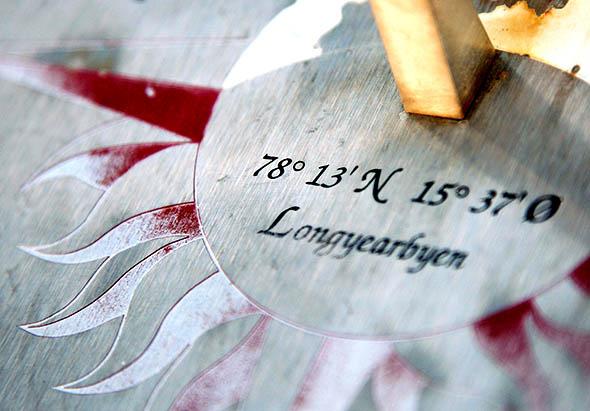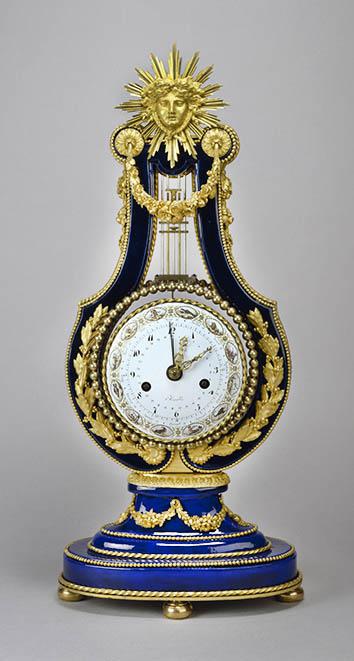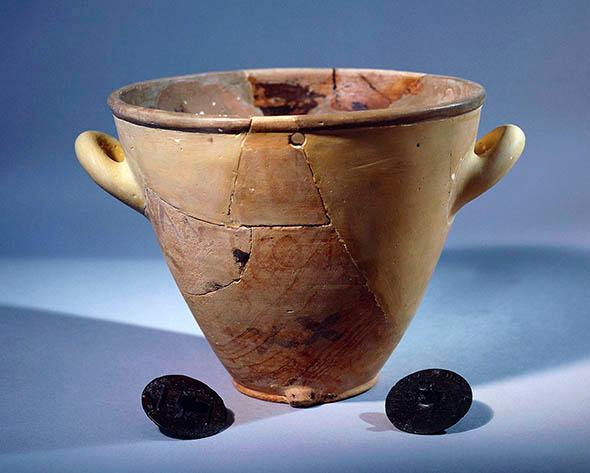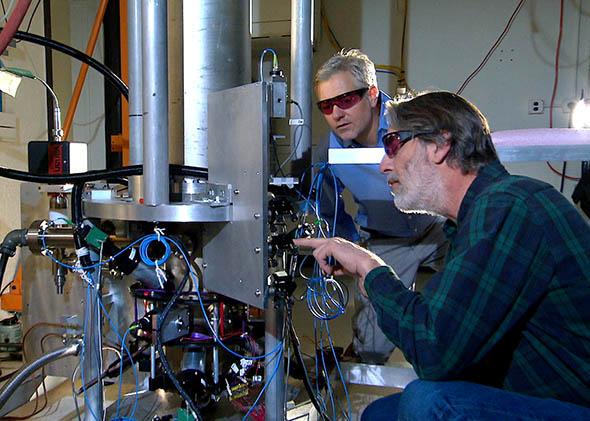The most accurate tool on the planet for plotting the tick-tock of life goes by the humdrum name of NIST-F2. It is a cesium fountain atomic clock at the National Institute of Standards and Technology in Boulder, Colorado. In the same way that a single cylinder of a platinum-iridium alloy entombed at the NIST campus near Washington, D.C. is the kilogram, the pulses delivered by this clock make it not merely a timepiece but the timepiece; all others are calibrated against it.*
For decades, the world’s primary timescale, Universal Coordinated Time, has been hitched to the numbers put forth by a network of atomic clocks scattered around the globe, including NIST-F2. Because NIST-F2 is more precise than other atomic clocks, it’s reasonable to say that it is the most accurate clock humanity has ever built. It also happens to be more accurate at keeping time than Mother Nature, a statement that is both true and controversial, for reasons we will get to in a carefully clocked minute.
NIST-F2 works by fiddling with the spin of electrons within cesium atoms. The 12-foot-tall machine uses lasers to corral about 100 million cesium atoms into a tight configuration that slows their motion and cools them to nearly absolute zero. More lasers nudge the cluster up through a microwave chamber, and then gravity brings it back down again. The carefully tuned microwave radiation changes the state of the cesium atoms. In the 1950s, scientists calculated the number of cycles of this radiation that occur during the most precise astronomical definition of a second. That number is 9,192,631,770, which looks like digit soup to most of us, but time nerds know it instantly. A second, at least in the standards sense of it, is not one-sixtieth of a minute or even one of 86,400 parts of a day. It is “the duration of 9,192,631,770 periods of the radiation corresponding to the transition between the two hyperfine levels of the ground state of the cesium 133 atom.”
There is perhaps no more fundamental requirement of our networked world than precise timekeeping. Consider the power grid. Electricity generation is a rapid-fire calibration of demand and transmission capability, relying on perfect synchronization to match and track demand. A misstep of a few microseconds could black out half the country.
And it’s like that for all systems governing modern life: air traffic control, high-speed stock trades, time-stamped legal documents, automated manufacturing, missile guidance, robotic surgery, weather forecasting, cellular networks, astronomical observations, in-car navigation. Our world relies on computers everywhere constantly exchanging data packets. To do that, they must agree exactly what time it is now and X seconds from now. It’s not money that makes the world go round. It’s precision timekeeping.

Photo by Chris Jackson/Getty Images
Yet the remarkable precision made possible by atomic clocks has led to a peculiar problem, one so deeply embedded within our digital infrastructure that one may mistake it for ephemera.
Do not be mistaken.
At issue is the blending of two timescales. Time tracked by atomic clocks is diverging from time as determined by that most basic of timepieces: the rotating Earth. Whereas the best atomic clocks today have an error rate that translates into roughly one misshapen second every 100 million years, Earth, by comparison, is unreliable. That’s because the planet’s rotation is irregular and gradually slowing down. (It may feel like life passes by in a blink, but days are actually getting longer, albeit slowly.) This gradual deceleration, mixed with shorter-term changes to Earth’s rotational velocity, make the heavens a less than trusty timekeeper.
To keep our atomic clocks from running too far ahead of time as determined by the Earth’s rotation, every year or two the captains of global timekeeping add a second to atomic time before broadcasting this adjusted time out to the world as Universal Coordinated Time.
The adjustment’s unassuming little name is the leap second. Ten of them were tacked on to UTC all at once in 1972, and another 25 have been added since. No. 26 is slated for the end of June 30, just before midnight. The decision is taken whenever it looks like the difference between Earth rotation time and atomic time will exceed 0.9 seconds. In the decades and centuries ahead, these adjustments will become more frequent, as often as once a month, if not more.
This tweak can lead to all sorts of trouble. In the summer of 2012, the Internet lit up with news about clocks gone haywire. “Y2K 2.0: How a Second Brought Down Half the Internets,” was BuzzFeed’s cutesy headline. Temporary outages hit Reddit, Mozilla, Gawker, LinkedIn, StumbleUpon, Yelp, Qantas Airlines’ ticketing service, and others. A couple of years before that, the leap second caused a pharmaceutical company to overcook a batch of medicines, and at one point jets on a U.S. aircraft carrier weren’t all tuned to the same timescale, and could have been out of synch by as much as half a minute.
Part of the problem is that leap seconds can’t be regularly scheduled, like the leap year. Both are adjustments that account for the fact that the calendar doesn’t mesh perfectly with the natural world. But because Earth’s wobble isn’t predictable, leap seconds aren’t either. That means software engineers have, at most, six months advance notice to prepare for it.
One faction of the world’s timekeeping club thinks that such problems are harbingers of catastrophe. When the leap second was inserted in 2012, engineers operating EGNOS, Europe’s satellite navigation system, reported that they couldn’t even anticipate the impact of the change, and that managing it could require 72 hours of down time. Luck was on their side in that nothing terrible happened, but the episode hardly engenders confidence in our ability to handle this occasional rejiggering of the timescale that underlies pretty much all of modern civilization.
That summer, flight controllers at Copenhagen International Airport decided that the least complicated way to keep things running smoothly during a leap second event was to tell pilots in the air that they were on their own for a few minutes, sign off, reboot, and then call up the planes again. That might work in the middle of the night at a smaller European airport, explains Poul Henning-Kamp, a Danish software consultant who specializes in leap second fixes. “But this would not be very practical for Tokyo or LAX where leap-seconds happen during busy hours.”
Leap second critics say this once reasonable, even elegant, hack has transmuted into an expensive problem at best, and quite possibly a ticking time bomb. We should dump the idea of time relating to the sun’s position. Atomic clocks should define the day, end of story.

Image courtesy NYPL/Creative Commons
On the other side of the debate is a small but resolute group of astronomers—and the British government. They argue that the leap second was and remains a smart fix, and that keeping time without any reference to the position of objects in the heavens is contrary to our understanding of the universe and our place in it. We adjust our clocks all the time: for daylight saving time, when traveling to a new time zone, or if an old timepiece needs rewinding. What’s so ghastly about this one particular adjustment?
This fall in Geneva, the international body charged with setting a standard for time meets to rule on the fate of the leap second, which means this question is coming to a head. (It also means the decision will be made mainly by bureaucrats, not scientists.) Should we abandon the sun once and for all and track time only with the restless ticking of subatomic particles? Or should we stick with the heavens, tuning the world’s clocks every now and then so that they never drift too far out of synch with the time as determined by high noon in Greenwich, England?
* * *
Divvying up the day into segments—inventing hours, really—dates back at least 4,000 years to ancient Egypt. Synchronizing clocks became necessary in the 19th century, when the rapid expansion of railways made it clear that time couldn’t just be a local measure. In 1884, delegates from around the globe gathered in Washington, D.C. to devise an international accord on time and longitude—to define a standard. This was when Greenwich Mean Time was anointed as the reference, the baseline against which the clocks of the world would be set. Every degree of longitude around the globe would correspond to a four-minute time difference away from mean solar time on that verdant hilltop just east of London.
In the 1950s, British physicist Louis Essen built the first atomic clock. As he wrote, it was becoming clear that the then-standard for the second, Earth’s rotation, “was no longer adequate for modern practical applications in the fields of air navigation and communication.” Seconds determined by astronomical observations just couldn’t cut it anymore.
In 1967 that the new definition was formally accepted and adopted for time immemorial, or at least until something new and better came along.
The atomic clock, Essen noted, “did not give the time of day, of course, but this is not required.” Not required because time of day is a social construct. Yet almost as fast as atomic time became the new norm, the question arose of how to make that mesh with civil time, or at least with the notion that noon and the sun’s zenith are related. Essen believed the leap second was “an excellent compromise.” The world would simply have two time signals, one determined by atomic clocks and the other determined the old-fashioned way. They could drift a little but never too much. Easy enough.
If not for GPS. Introduced in the 1970s, Global Position Satellite technology would provide unprecedented precision of location and time data. Coders over the next few decades began pegging the clocks of various software programs to GPS system time, not Coordinated Universal Time—the one that gets tweaked by the occasional leap second.

Photo courtesy Walters Art Museum/Creative Commons
By the late 1990s, astronomer Dennis McCarthy of the U.S. Naval Observatory had heard of enough glitches and tangles with leap second implementation, and witnessed enough chaotic leap-second nights at the USNO, that he began seriously considering what it would mean to end the practice altogether. McCarthy, who would ascend the ranks to become USNO’s director of time, began writing and speaking about the possibility that the leap second’s utility had run its course.
There are two broad categories of problems caused by leap seconds. The first is reconciling GPS and UTC signals. In the GPS transmission coming down from the satellite there is a small segment of code that essentially says the difference between GPS and UTC time is X seconds. Every time there is a leap second, that information has to be changed in the GPS message. In other words: It’s a window of vulnerability. The other potential hazard is due to the disruption of what is supposed to be an uninterrupted sequence. “Time is a succession of small events called seconds,” says Elisa Felicitas Arias, director of the time department at the Bureau International des Poids et Mesures in Paris. “You can’t just interrupt it.”
In 2004, U.S. delegates to the International Telecommunication Union radio-communication group, led by McCarthy, formally proposed an end to the leap second. The response was mixed.
“My view is that if there’s a bug you fix it. That doesn’t mean you redefine time,” says Rob Seaman, data engineer at the National Optical Astronomy Observatory in Tucson. Nixing the leap second will result in costly and difficult changes to telescopes worldwide because they are, in a way, clocks, taking the measure space-time. But the more profound criticism from Seaman and other scientists is that setting the time without any regard for the position of objects in the heavens means decoupling the sun and our clocks. You can’t define a fraction of a day—a second—only by looking down at some electronic device. You must look up to the heavens, too.

Photo by DEA/G. Nimatallah/De Agostini/Getty Images
Think about time on another planet, for example. Mars days aren’t 24 hours long, but they have sunrise, sunset, and a bunch of minutes in between, just like on Earth. A day, therefore, is not and cannot be some arbitrary standard.
Besides, the leap second is basically working fine, says Peter Whibberley, senior research scientist for time and frequency at Britain’s National Physical Laboratory. More than 40 years in to this practice, it hasn’t caused any of the apocalyptic, Y2K-like scenarios that people have forecast. “Or if they have happened, we haven’t heard of them.”
In Whibberley’s view, because we already live in a world anchored to atomic time, not Earth-rotation time, the leap second debate isn’t even really about timekeeping. Atomic clocks do that very well, thank you very much. But with the leap second, we can look at a clock and know both how many seconds have elapsed and the time of day in astronomical terms, at least within a margin of 0.9 seconds. “All we’re doing is changing how we label time when it’s actually displayed on our [everyday] clocks,” Whibberley says.
If there are compelling reasons to make this change, Whibberley says, he hasn’t seen them. Besides, shouldn’t the onus be on those who want change to prove that their new approach will be superior to the status quo, and won’t result in unintended consequences?
Some experts have suggested Britain’s defense of the leap second has more to do with national pride and preserving the prestige of Greenwich Mean Time than it does any scientific, technical, or even economic rationale. Whibberley says this is rubbish. To make the point, he mentions current legislation in Parliament to shift Britain from GMT to European time, primarily for business reasons. That hardly sounds like the position of officials blinded by nostalgia.
Yet last year, Britain’s science minister David Willetts was warning that “time could become meaningless” if world leaders went ahead with a plan to scrap the leap second. “My view is that without leap seconds we will eventually lose the link between time and people’s everyday experience of day and night … the relatively frequent but modest corrections are better than allowing a discrepancy to build up. Greenwich Mean Time would slowly move west towards America. I want to keep it in Britain.”
The drift would actually be east toward Paris first, where Arias of the International des Poids et Mesures finds it ironic that Britain, the country where the atomic clock was born, is now so loudly defending what she calls “the fictitious discontinuity of time.”
To people like McCarthy, talk about sunsets at lunchtime distract from the real issue—and dangers—at hand. The problem is that the companies and institutions that are hit with difficulties due to the leap second have little incentive to make this fact known, and all kinds of incentive to keep it secret. How secure would you feel, for instance, upon learning that certain elements in the military, for instance, or the chiefs of financial markets were having a tough time keeping time?

Image engraving by J. Pass/Wellcome Library/Creative Commons
In 2008, McCarthy attended a lecture at the Naval Observatory, delivered by Kamp, the Danish software consultant. Kamp shared a worrisome anecdote: During a leap second event years ago, a new air-traffic control radar system in a certain country (Kamp would not divulge which country) was suddenly replaying radar tracks from exactly one year prior.
McCarthy thought it was the kind of smoking-gun evidence he needed to finally win over skeptics who still think the leap second is quaint, harmless, and kind of cool. Yet because nothing catastrophic happened (the radar tracks returned to the proper readings quickly), McCarthy’s warnings, yet again, received little notice. “It’s the most frustrating experience of my life,” he says. “We cannot continue to just coast along and pretend that this is not a problem.”
After years of punting, stalemate, and fake resolutions to punt some more, 2015 is, or at least potentially could be, a real deadline for the U.N. special agency that rules on the matter. “If we come away from the 2015 meetings and don’t change the definition of UTC, we won’t change it for many many years,” Arias says. But few are optimistic about the upcoming deliberations. McCarthy, despite having spent countless hours of his life on this matter, is now convinced nothing will ever happen until some tragedy forces the issue. “You need some kind of irreversible consequence. That means people dying.”
Maybe it’s time we took the time to make sure that doesn’t happen.
*Correction, June 10, 2015: This article originally misstated that a single meter-long rod in Paris is the standard for the meter. The rod is no longer the standard for the meter. The sentence has been updated to compare the atomic clock’s determination of the second to the platinum-iridium alloy that determines the kilogram.
